Why this resume works
- Highlights industry-specific skills: By detailing roles like veterinary technician and animal care specialist, the applicant effectively showcases important healthcare skills needed in the veterinary field.
- Quantifies accomplishments: Including measurable accomplishments, such as assisting with 50+ surgeries monthly and reducing disease by 40%, emphasizes tangible impact.
- Illustrates problem-solving ability: Implementing a pet wellness program and an electronic records system highlights problem-solving skills, showcasing innovative solutions to improve clinic efficiency.
More Veterinary Technician Resume Examples
Browse our veterinary technician resume examples to learn how to highlight your clinical skills, animal care experience, and certifications. These veterinary resume samples will help you create a compelling resume to impress potential employers.
Entry-Level Veterinary Technician
Why this resume works
- Puts skills at the forefront: The skills-based resume format ensures skills like veterinary diagnostics and client education are immediately visible, ideal for entry-level positions.
- Effective use of keywords: Strategically placed keywords such as “veterinary technician” and “surgical assistance” improve the resume’s compatibility with ATS software.
- Shows digital literacy: Demonstrating digital savvy, the applicant showcases computer skills by implementing an efficient record-keeping system, reducing errors significantly while optimizing clinic operations.
Mid-Level Veterinary Technician
Why this resume works
- Points to measurable outcomes: By showcasing achievements like a 30% increase in client satisfaction and zero surgical complications, the applicant emphasizes their impact on veterinary clinic outcomes.
- Includes a mix of soft and hard skills: The resume seamlessly mixes technical expertise with interpersonal skills, showcasing abilities from surgical assistance to effective communication with clients.
- Demonstrates language abilities: Language skills in Spanish, French, and German showcase cross-cultural interactions in veterinary settings.
Experienced Veterinary Technician
Why this resume works
- Showcases impressive accomplishments: By implementing a surgical prep process that cut preparation time by 40%, the applicant’s accomplishments reveal compelling contributions to veterinary operations.
- Focuses on work history: The applicant uses a chronological resume format, effectively showcasing their extensive work history and steady career progression in animal care roles over nearly two decades.
- Emphasizes leadership skills: Consistently managing health protocols for over 300 rescue animals annually, the applicant exhibits strong leadership skills through team coordination and initiative-driven success.
Veterinary Technician Resume Template (Text Version)
Emily Lee
Crestwood, KY 40021
(555)555-5555
Emily.Lee@example.com
Professional Summary
Experienced veterinary technician skilled in animal care, diagnostic testing, and surgical assistance. Proven track record in delivering preventive healthcare and managing patient records, ensuring optimal pet health and customer satisfaction.
Work History
Veterinary Technician
Greenfield Animal Hospital – Crestwood, KY
August 2022 – August 2025
- Assisted with surgeries on 50+ animals monthly
- Administered medications saying to 100+ pets annually
- Performed diagnostic tests on 75+ animals monthly
Animal Care Specialist
Riverside Veterinary Clinic – Crestwood, KY
July 2020 – July 2022
- Conducted 150+ routine pet exams annually
- Trained 20 new staff in animal care protocols
- Implemented preventive healthcare measures reducing disease by 40%
Pet Health Assistant
Harmony Pet Wellness Center – Louisville, KY
August 2019 – June 2020
- Supported vet checks for 200+ animals yearly
- Managed pet records for 300+ clients
- Prepared and maintained examination areas improving efficiency by 30%
Languages
- Spanish – Beginner (A1)
- French – Beginner (A1)
- Mandarin – Intermediate (B1)
Skills
- Animal Care
- Surgical Assistance
- Diagnostic Testing
- Health Screening
- Preventive Care
- Patient Records Management
- Client Communication
- Medication Administration
Certifications
- Certified Veterinary Technician – American Veterinary Medical Association
- Animal CPR Certification – Pet Emergency Education
Education
Master’s Degree Veterinary Science
University of California, Davis Davis, California
June 2019
Bachelor’s Degree Animal Biology
California State University, Long Beach Long Beach, California
June 2017
Related Resume Guides
Advice for Writing Your Veterinary Technician Resume
Tailoring your resume to highlight your skills in animal care, medical procedures, and client communication can make all the difference. Explore our tips on how to write a resume for the veterinary field and discover how to effectively present your passion for animal health and welfare.
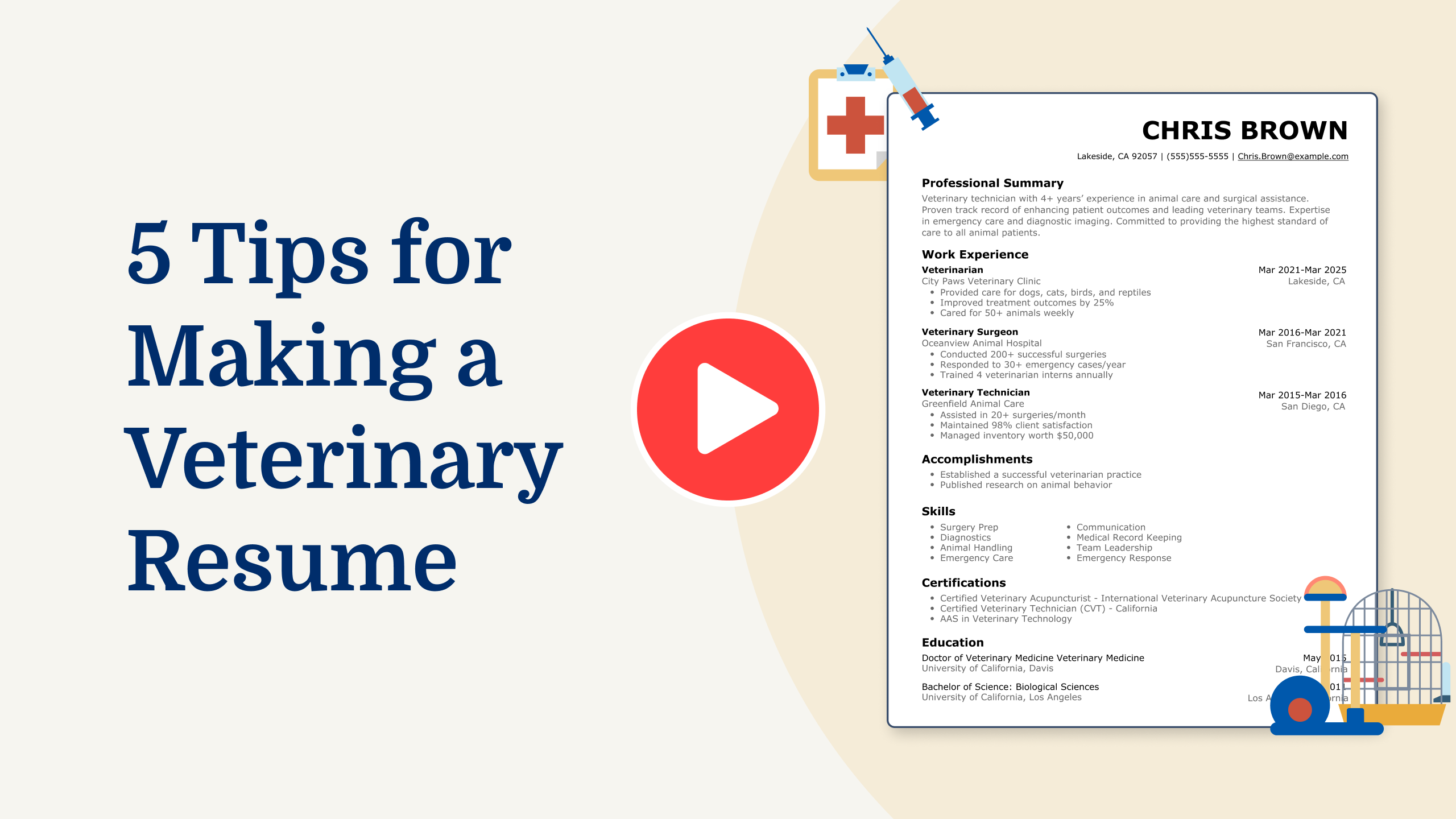
Write a strong professional summary
A professional summary on a resume is a brief introduction meant to grab the hiring manager’s attention. It’s your chance to make a strong first impression and can help readers decide whether you fit the role. People often choose between writing a summary and an objective at the top of their resumes.
A professional summary is typically three to four sentences that highlight your experience, skills, and achievements. It’s best for those with some experience in their field because it focuses on what you’ve done and how you’ve added value in past roles.
In contrast, resume objectives are statements about your career goals and are ideal for entry-level applicants, career changers, or those with employment gaps. While summaries focus on “what I’ve accomplished,” objectives emphasize “what I aim to contribute.”
Next, we’ll look at examples of both summaries and objectives tailored to different industries and levels of experience, like veterinary technician roles. Explore our professional resume examples for additional inspiration.
Veterinary technician resume summary examples
Entry-level
Recent veterinary technology program graduate with a strong foundation in animal care and medical procedures. Holds certification as a veterinary technician (CVT) and experienced in assisting with routine examinations, vaccinations, and laboratory tests. Eager to support veterinarians and deliver compassionate care to animal patients.
Mid-career
Skilled veterinary technician with over six years of experience in small animal clinical settings. Proficient in surgical assistance, anesthesia monitoring, and client education on pet health care. Licensed in New York, certified in dental radiology for animals, and recognized for excellent team collaboration and problem-solving abilities.
Experienced
Veterinary technician with specialized expertise in emergency and critical care. Certified Veterinary Technician Specialist (VTS) with advanced skills in life-saving procedures and intensive patient monitoring. Known for leading teams during high-stress situations and implementing quality improvement initiatives that improve patient outcomes.
Veterinary technician resume objective examples
Recent graduate
Dedicated and eager recent graduate with an Associate Degree in Veterinary Technology seeking a veterinary technician position to use animal care knowledge and technical skills in a supportive veterinary practice. Committed to assisting veterinarians in delivering top-notch medical care and improving the well-being of animals.
Career changer
Passionate professional transitioning into veterinary technology, bringing solid experience in customer service and communication from previous roles. Ready to contribute to a cohesive veterinary team while learning hands-on animal care techniques and supporting pet health through compassionate service.
Specialized training
Certified animal care specialist with additional training in wildlife rehabilitation, looking to begin a career as a veterinary technician. Excited to apply specialized skills in emergency and critical care environments, helping diverse species recover and thrive through attentive support.
Struggling to showcase your skills as a veterinary technician? Our Resume Builder makes it easy to highlight your experience and create a professional resume in minutes.
Include relevant certifications and training
Listing certifications and training is important for a veterinary technician because it shows you have the skills needed to care for animals. These credentials prove that you can handle tasks like taking X-rays or giving shots. In technical fields, having the right certifications helps employers trust that you can do the job well. It’s a good idea to put your certifications in a special section on your resume so they stand out.
- Certified Veterinary Technician (CVT)
- Licensed Veterinary Technician (LVT)
- Registered Veterinary Technician (RVT)
- Fear Free Certification
- Veterinary Technician Specialist (VTS) in Emergency and Critical Care
Having these certifications makes you more competitive as a veterinary technician. They show that you’re ready to meet industry standards and give excellent animal care. Adding them to your resume can make it easier for employers to see your qualifications.
Example of a certifications section
Certified Veterinary Technician (CVT)
Issued by: American Association of Veterinary State Boards (AAVSB)
Issued 2021
Veterinary Technician Specialist in Emergency and Critical Care (VTS-ECC)
Issued by: Academy of Veterinary Emergency & Critical Care Technicians
Expires 2025
Fear Free Certified Professional
Issued by: Fear Free, LLC
Issued 2023
Anesthetic Monitoring Certification
Issued by: American Animal Hospital Association (AAHA)
Expires 2024
Animal Behavior Management Certificate
Issued by: International Association of Animal Behavior Consultants (IAABC)
Issued 2022
Select a polished and well-organized resume template that effectively showcases your skills and qualifications to stand out to hiring managers in the veterinary field.
Showcase your work experience
When applying for a veterinary technician position, it’s important to showcase your work experience effectively. This section of your resume helps potential employers see what you’ve done in the past and how it aligns with their needs. Start by listing your job experiences in reverse chronological order.
This means you should list your most recent job first, then go backwards. For each role, include the job title, employer’s name, location, and employment dates. Use clear language that demonstrates what you did and achieved in each role.
Use action words to describe your responsibilities and accomplishments. Instead of just saying “helped with animals,” try something like “assisted veterinarians in surgeries” or “monitored animal recovery.” Including measurable results can be beneficial; for example, say “reduced patient wait times by 20% through efficient check-in processes.” This clearly shows how you contributed to the workplace.
For a veterinary technician role, focus on skills such as animal care, lab testing, surgical assistance, and client communication. Highlight any special tasks you handled or improvements you made in those areas. By clearly outlining these points using specific examples and achievements, you’ll help employers see why you’re a great fit for their team.
5 veterinary technician work history bullet points
- Administered medications and vaccines to over 200 animals monthly, contributing to a 95% improvement in clinic health outcomes.
- Assisted veterinarians during surgical procedures, resulting in a 50% reduction in operation time due to improved efficiency.
- Conducted routine laboratory tests and maintained accurate records, which led to a 40% increase in diagnostic accuracy.
- Trained and supervised new veterinary assistants, improving team productivity by 25% within the first quarter.
- Implemented a new inventory management system that reduced medical supply shortages by 30%, ensuring consistent animal care.
Opt for a resume format that highlights your animal care expertise, technical skills, and experience with medical procedures.
Match your resume with the job description
Tailoring resumes to job descriptions is key because it helps job seekers stand out to employers and pass through applicant tracking systems (ATS). These systems scan resumes for specific keywords and phrases from job postings, so it’s important to customize your resume closely with the job description.
An ATS-friendly resume incorporates keywords and phrases from the job description that align with your skills. Doing this boosts your chances of catching the attention of hiring managers who use ATS to filter applications.
To identify keywords in job postings, pay attention to frequently mentioned skills, qualifications, and responsibilities. For a veterinary technician role, examples might include “animal care,” “clinical assessments,” or “veterinary team collaboration.” Using these exact phrases can help your resume stand out to employers and applicant tracking systems.
Incorporate these terms naturally by tailoring your job descriptions. For example, you can rephrase a statement like “Provide high-quality animal care” to “Delivered high-quality animal care to support patient health and recovery,” ensuring your experience aligns with the job description while remaining authentic.
You can use our ATS Resume Checker to scan your resume for potential issues and receive on-the-spot feedback to improve your resume score.
FAQ
Do I need to include a cover letter with my veterinary technician resume?
Yes, including a cover letter with your veterinary technician resume can improve your application and provide additional context for your skills.
A cover letter allows you to express your passion for animal care and highlight relevant experiences that make you a great fit for the role.
For instance, if the clinic specializes in exotic animals or has a unique treatment approach, you can discuss any related experience or interest you have in that area.
Consider using our Cover Letter Generator to craft a personalized message that aligns with the job description and highlights your strengths as a veterinary technician.
You might also find it useful to look at cover letter examples tailored to veterinary roles to better understand how to structure your own letter effectively.
How long should a veterinary technician’s resume be?
For a veterinary technician, typically a one-page resume is sufficient to showcase your key skills and experience. This format works well if you’re early in your career or have a straightforward work history in animal care or veterinary settings.
However, if you have extensive experience, specialized training, or certifications such as anesthesia monitoring or dental prophylaxis, a two-page resume might be appropriate. Just ensure each detail you include is relevant to the job you’re applying for.
Explore our guide on how long a resume should be for more tips on choosing the right length for your professional journey.
How do you write a veterinary technician resume with no experience?
When crafting a resume with no experience for a veterinary technician role, focus on highlighting your education, skills, and any relevant volunteer work that demonstrate your preparedness for the position. Here are a few tips to help you get started:
- Emphasize your education: Start by detailing your degree, diploma, or certification in veterinary technology. Include the institution’s name, graduation date, and any honors received.
- Highlight relevant coursework and projects: If you’ve completed coursework related to animal care or participated in school projects involving animals, list these as they can showcase your familiarity with key concepts in veterinary medicine.
- Showcase volunteer or internship experiences: Any volunteer work at animal shelters, internships at vet clinics, or shadowing experiences can be valuable. Describe tasks you performed, such as assisting in exams, handling animals, or maintaining records.
- Demonstrate transferable skills: Skills like communication, attention to detail, and teamwork are important for a vet tech. If you’ve gained these from other roles or activities, make sure to highlight them.
Consider checking out resources on writing a resume with no experience to find more examples and tips tailored for beginners entering the workforce.
Rate this article
Veterinary Technician
Additional Resources
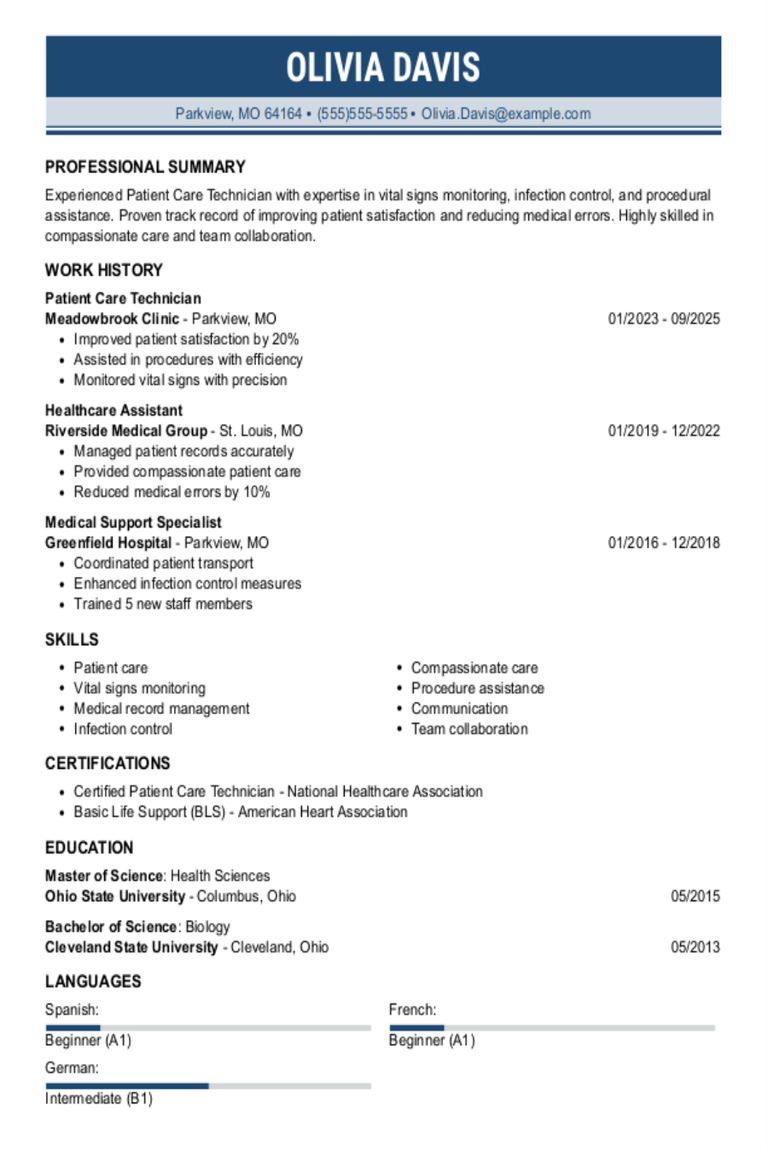
Patient Care Technician Resume Examples & Templates for 2025
Explore patient care technician resume examples to see how to highlight your skills in assisting patients, monitoring vital signs, and supporting medical staff. Discover tips for showcasing your experience in
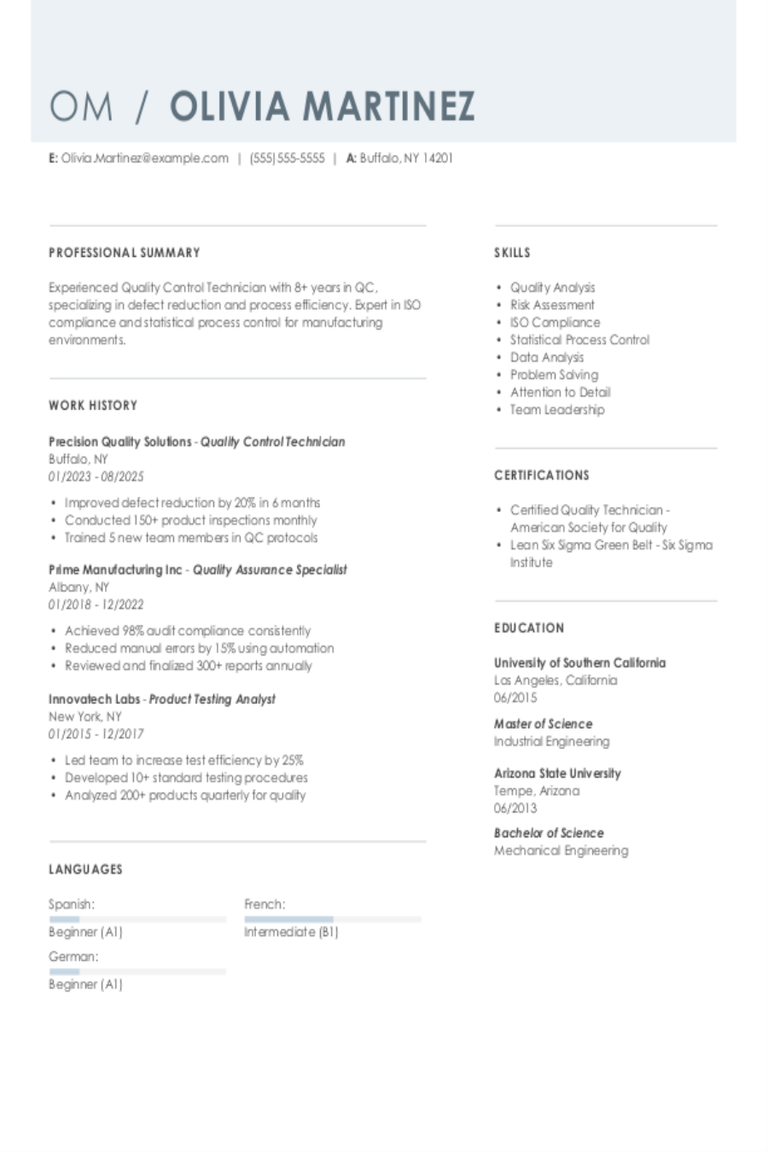
Quality Control Technician Resume Examples & Templates for 2025
Browse quality control technician resume examples to see how to list your skills in testing and inspection. Discover tips on sharing experiences that demonstrate attention to detail and problem-solving abilities
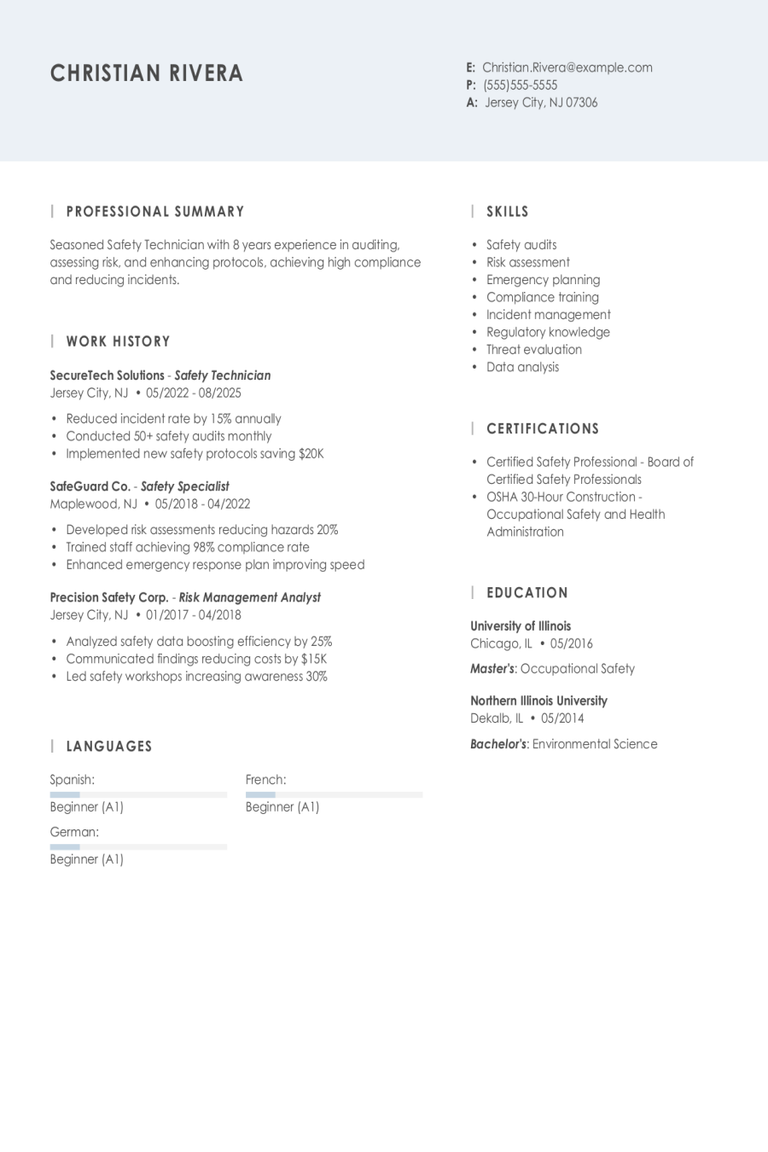
Safety Technician Resume Examples & Templates for 2025
Explore safety technician resume examples that focus on skills like problem-solving, equipment checks, and teamwork. These examples and tips will help you show employers you’re ready to keep workplaces safe
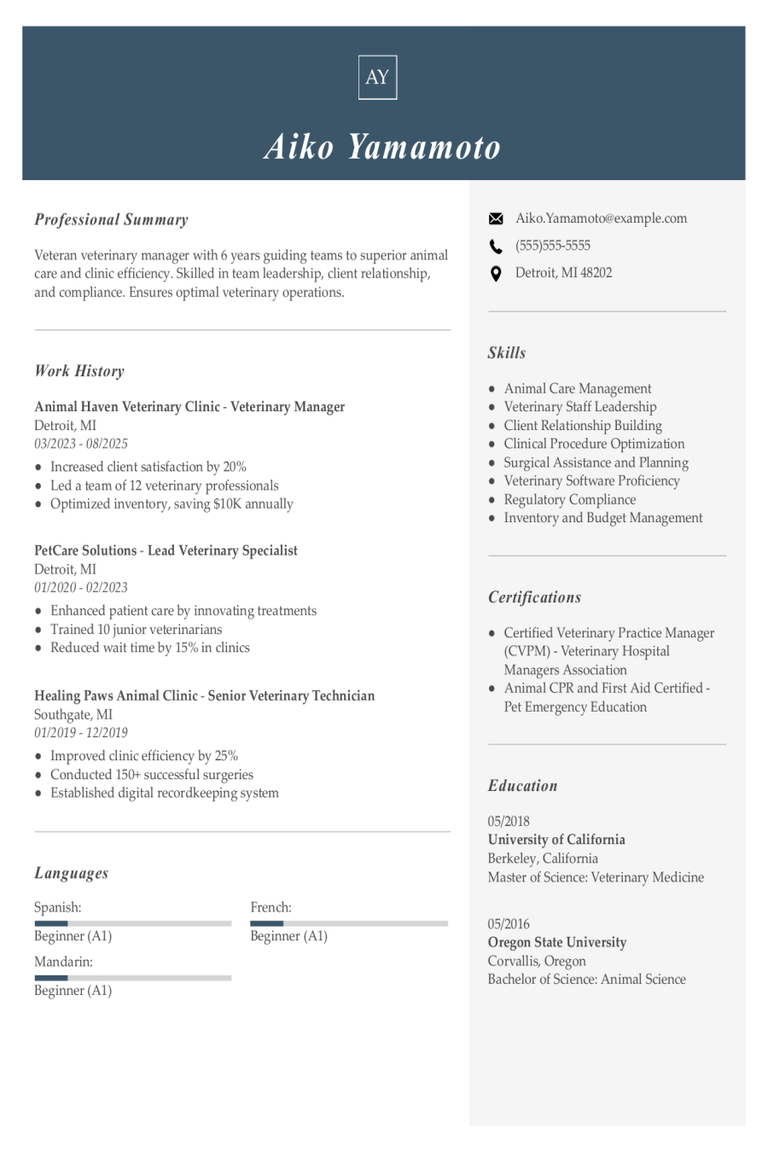
Veterinary Manager Resume Examples & Templates for 2025
As a veterinary manager, your resume must show how you care for animals, lead a team, and run a clinic smoothly. These resume examples show you how to highlight your
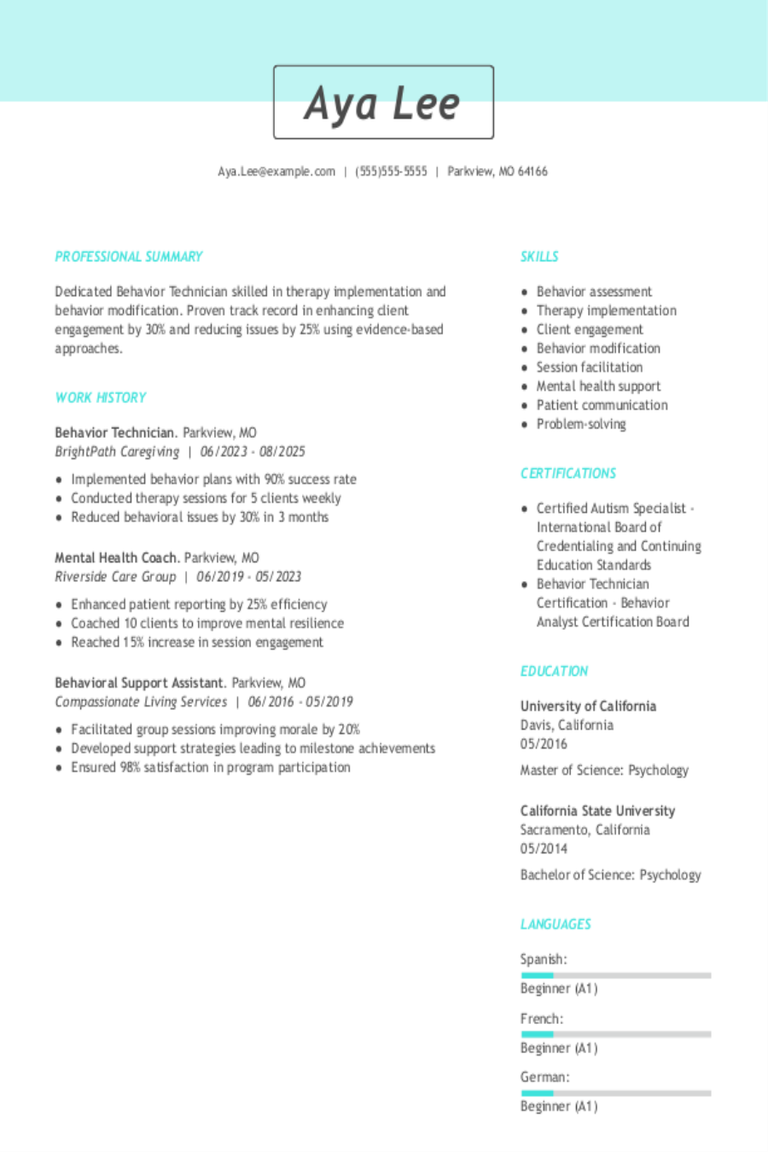
Behavior Technician Resume Examples & Templates for 2025
Discover behavior technician resume examples and learn how to showcase your hands-on experience and make a great impression on potential employers.Build my resumeImport existing resumeCustomize this templateWhy this resume worksQuantifies
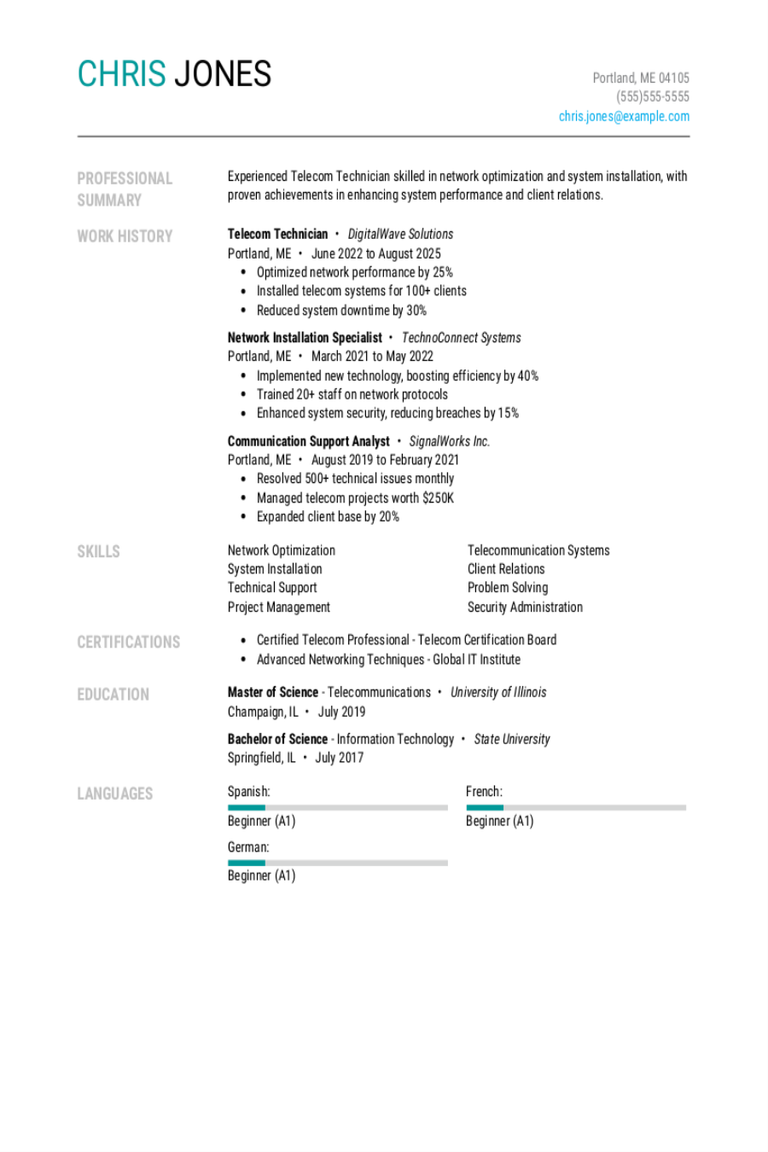
Telecom Technician Resume Examples & Templates for 2025
Browse telecom technician resumes to see how to showcase your experience in fixing and maintaining communication networks, setting up equipment, and solving technical problems. These examples and tips will help
